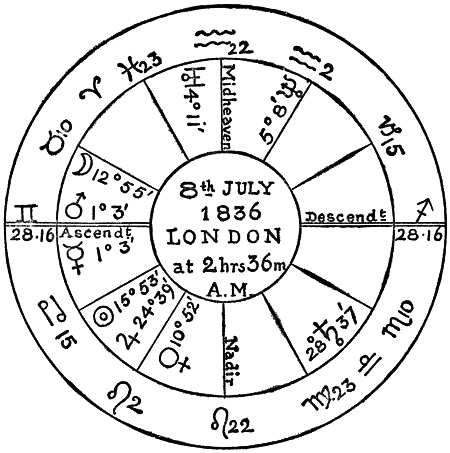Entry tags:
The Lansing Method: A More Flexible Approach for Divination
Introduction

Currently, something of a divide exists in divination practices. On the one hand we have astrology. Consider this natal chart, for example (Sepharial). In the twelfth house, located on the left directly above the horizontal ascendant line, we find both the moon and Mars. The eleventh house just above it, though, is empty, as are three consecutive houses on the right. These kinds of arrangements are typical in natal charts, where some houses may have multiple planets while others have none.
On the other hand, with sortilege methods of divination, such as tarot, runes, and ogham, the typical techniques produce a different pattern. The layout has one or more positions, and one symbol is drawn for each. In a Celtic cross spread, for example, one symbol is drawn for each of the ten positions. The key difference is that each position always has exactly one symbol, unlike in astrology. Often this is fine for providing the answers we need.
Sometimes, however, we may want a more detailed picture. We may find ourselves in a situation where some aspects are influenced by many factors and others by few or none. One quick alternative that works with sortilege methods is to grab a handful of tokens instead of just one for each position. Again, sometimes that may be enough. Other times, though, we may want to use a more systematic approach, especially one that allows for empty positions.
( Read more... )

Currently, something of a divide exists in divination practices. On the one hand we have astrology. Consider this natal chart, for example (Sepharial). In the twelfth house, located on the left directly above the horizontal ascendant line, we find both the moon and Mars. The eleventh house just above it, though, is empty, as are three consecutive houses on the right. These kinds of arrangements are typical in natal charts, where some houses may have multiple planets while others have none.
On the other hand, with sortilege methods of divination, such as tarot, runes, and ogham, the typical techniques produce a different pattern. The layout has one or more positions, and one symbol is drawn for each. In a Celtic cross spread, for example, one symbol is drawn for each of the ten positions. The key difference is that each position always has exactly one symbol, unlike in astrology. Often this is fine for providing the answers we need.
Sometimes, however, we may want a more detailed picture. We may find ourselves in a situation where some aspects are influenced by many factors and others by few or none. One quick alternative that works with sortilege methods is to grab a handful of tokens instead of just one for each position. Again, sometimes that may be enough. Other times, though, we may want to use a more systematic approach, especially one that allows for empty positions.
( Read more... )